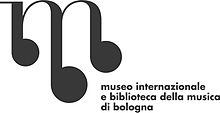Palazzo Sanguinetti
 |
|
 |
|
| Established | 2004 |
|---|---|
| Location | Strada Maggiore 34, Bologna, Italy |
| Type | Museum, Historic site |
| Director | Francesca Bruni |
| Website | http://www.museomusicabologna.it/ |
Coordinates: 44°29′34″N 11°21′01″E / 44.4929°N 11.3502°E
The Museo internazionale e biblioteca della musica is a music museum and music library in the Palazzo Aldini Sanguinetti, in the historic center of Bologna, Italy.
The Civico Museo Bibliografico Musicale was founded in 1959 to hold the city's collection of musical objects. It was renamed Museo Internazionale e Biblioteca della Musica in 2004 when the museum's current site, the Palazzo Sanguinetti, opened to the public. The palace was reopened after a long and careful restoration that brought the rich, interior frescoes back to their original splendour. These frescoes were first completed between the late 18th and early 19th centuries, and provide one of the finest examples of Napoleonic and Neoclassical decoration.
The purpose of the museum was to make the public aware of the rich musical heritage owned by the Comune di Bologna. Until recently, much of this heritage remained confined in warehouses – primarily due to lack of adequate space – and was only brought out occasionally for temporary display.
Palazzo Sanguinetti offered the possibility to enhance the cultural value of such precious musical heritage and to provide an environment worthy of the priceless items displayed. The palace also guarantees ideal conditions for managing and conserving these items.
The institute is now divided into two sites. An ample selection of volumes, paintings, and musical instruments are displayed in the museum halls in Strada Maggiore 34 (Palazzo Sanguinetti), while the majority of bibliographic material is accessible in Piazza Rossini 2 (the ex-Convent of San Giacomo) in rooms attached to the G.B. Martini Conservatory of Music.
In the early 16th century, the original core of the Palazzo Sanguinetti belonged to the Loiani family. The building was sold in 1569 to the Bolognese brothers, Ercole and Giulio Riario, who were originally from Savona and were related to the della Roveres. Having acquired neighboring land and buildings, Senator Ercole Riario had the home reconstructed and enlarged. The individual homes were united into one structure, and construction on the impressive staircase, which still characterizes the building today, was likely begun. The second major reconstruction was commissioned by Count Antonio Aldini, to whom the Marquis Raffaello Riario Sforza had granted a long-term lease in 1796. Count Aldini tasked the architect Giovanni Battista Martinetti (1774–1830) with modernizing the building. A neighboring house was attached to the tower belonging to the Oseletti family, and the huge 16th-century hall was divide into two rooms, which correspond to the modern museum's two most spacious rooms – the vestibule, or the Room of Virtues, and the Ballroom.
...
Wikipedia
